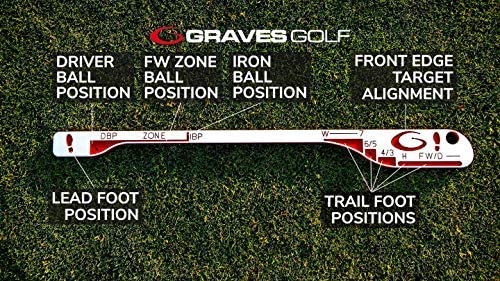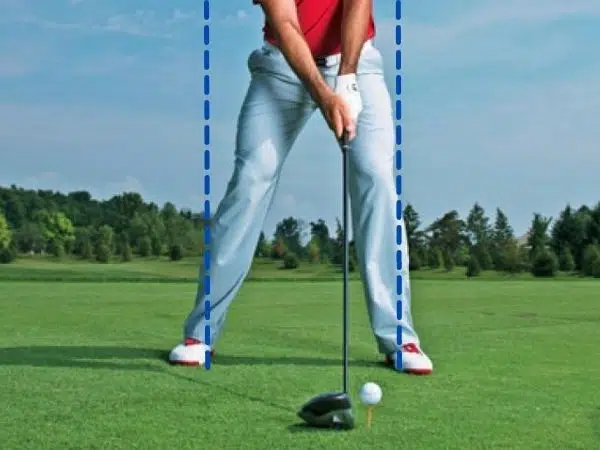To create a consistent, powerful golf swing you need a sturdy base – and getting the correct amount of width in your stance will go a long way to achieving this.
While mastering your takeaway, wrist positions or hip turn is higher on the priority list for many amateur golfers, the importance of a proper set-up with your feet shouldn’t be overlooked.
A too narrow stance may leave you unbalanced, while a stance that is excessively wide – despite it feeling secure and stable – may restrict your rotation and lead to other issues.
So, how wide should your stance be in your golf swing?
Most golf instructors say the width of your stance will depend on the club you are hitting. For driver, your feet should be slightly wider than shoulder width. For irons and wedges, they should be shoulder width apart. For pitching and chipping, your stance should be slightly narrower than shoulder width.
These are the most commonplace recommendations I could find from the majority of golf teachers online that will maximise your results and lead to improved consistency.
If you want an easy way to train the correct stance width without too much thought, I’d suggest you consider purchasing the Graves Golf Alignment & Ball Position Trainer (pictured below).

This affordable aid has markings indicating where your feet and ball position should be for each club, from driver right the way through to wedge, which is extremely handy when grinding away at the range.
But if you want to know more about the nitty gritty details of stance width in golf, read on.
Table of contents
Is it better to have a wide or narrow stance in golf?
Having a stance that is the correct width for each club will provide optimal results than a stance that is too wide, or too narrow. For this reason, wider is not necessarily ‘better’. A stance that is too wide may restrict rotation, just as a too narrow stance may leave you unbalanced.
I see so many amateur golfers, especially beginners, address the ball with their feet spread so far apart that it almost looks as though they’re attempting to do the splits.
Many of them do this as it feels more stable, but also because a wider stance lowers their body and brings their hands closer to the ball without needing to bend over too much.
It’s less common to see weekend warriors with a set-up position that is too narrow, as bringing the feet closer together can affect your balance and allow the hips to move more freely (and some golfers don’t like this ‘loose’ sensation in their backswing).
The sweet spot, as I’ll explain below, is matching your stance to each club to enable enough hip turn, while still offering stability.
How wide should my stance be in golf?
No club is the same when it comes to the width of your stance. It’s important to adjust your set-up position to cater for this. Below, I’ll elaborate further on the correct stance for every club.
Width of stance for driver
You want your stance to be slightly wider than shoulder width.
Because driver is the longest club in your bag, it will generate the most clubhead speed (if you want even more speed, read our guide on generating more lag).
To prevent these significant forces from ‘swinging you off your feet’, it’s important to anchor yourself to the ground with a slightly wider stance than you’d take with a mid-iron.
Width of stance for long irons/hybrids/fairway woods
Like driver, you want a stance that is slightly wider than shoulder width with your long irons, hybrids and fairway woods because of their length, and the speed you can create while swinging them.
If you want more advice on how to hit long irons and 3-woods, check out our guides for each.
Width of stance for mid/short irons
When using mid/short irons, which I’d classify as anything from a 5-iron through to a 9-iron, it’s better to narrow your stance so that it’s roughly shoulder width.
These clubs are shorter in length (unless, of course, you’re using Cobra one-length irons like Bryson DeChambeau), meaning you’ll be a little more bent over at address as having a stance that is too wide will bring you too close to the ball.
Width of stance for wedges
If you’re hitting a full wedge (check out the best options on the market here), it’s best to treat it similar to a short iron and take a stance that is shoulder width apart.
Doing so will allow your hips to move more freely and promote a controlled, smooth swing – which is essential if you’re trying to hit an exact yardage, or even trying to fly the ball past the pin and spin it back like the pros.
Width of stance for pitching/chipping
When pitching or chipping – and there is a difference, as we’ve explained in another article – it’s best to narrow your stance so that your feet are only a few inches apart.
This will free up your hips a lot more and allow you to play the shot more with the rotation of your chest, arms and shoulders, eliminating unnecessary movement with your hands.
Pitching and chipping in this manner – made possible by a narrow stance – will help you create a repeatable low point in your swing and improve your consistency of strike, along with distance control.
You’ll say goodbye to those chipping yips in no time!
Width of stance for putting
There is no right or wrong answer when it comes to how wide your stance should be when putting, largely because it’s a personal choice for each golfer (just as there are many options for grip technique also).
The width of your stance on the greens is also largely irrelevant as you don’t use your hips when putting, so it makes very little difference whether a wide stance restricts them from turning or not.
The best putters of all time each have their own style – 19-time major winner Jack Nicklaus had his trademark hunch (and also wore a glove), while someone like Champions Tour legend Bernhard Langer has a wider stance to accommodate his broomstick putter.
Pick a stance that is most comfortable for you and one that allows you to generate a consistent, repeatable putting stroke.
What happens if my golf stance is too wide?
A stance that is too wide will likely have a negative impact on your golf swing as it will restrict your hip turn, both in the backswing and downswing. This will create a myriad of inefficiencies that may cost you distance; cause a sliding of the pelvis, leading to early extension; and possibly make it difficult to control the low-point of your swing arc.
Of course, there are exceptions to the rule and there are players who have made a wide stance work for them in their swing.
One who comes to mind is the late Canadian enigma Moe Norman, who is regarded as one of the best ball-strikers of all time.
While his time on the PGA Tour was brief, Norman’s 55 professional wins worldwide landed him in the Canadian Golf Hall of Fame.
His famous ‘one-plane swing’ employed a very wide stance – particularly with driver – which enabled him to repeat it with almost mechanical precision.
But Norman was truly one-of-a-kind, and for the average golfer it’s likely you’ll see better results by sticking to the more commonly taught practices above (if in doubt, I’d always recommend seeing a professional golf instructor who can help you find a set-up position that suits your natural movement).
How does width of stance affect your golf swing?
Typically, a golf stance that is too narrow may lead to an unbalanced or unstable swing – especially when playing a full shot. On the other hand, a stance that is too wide can cause restriction of the hips, which may cause unwanted inefficiencies in your swing.
The widest your stance should ever get is slightly outside your shoulders, and this is only when hitting driver, fairway woods or long irons.
From there, the shorter the club gets, the narrower your stance should be (as a general rule).
It’s important not to confuse stance width with ball position – for a full explanation about where the ball should be relative to the width of your stance, check out another article here.
Final message
When it comes to the width of your stance in the golf swing, it’s important not to overcomplicate things.
Having your feet slightly wider than shoulder width for your driver and longer clubs, and getting gradually narrower as you progress through your mid and short irons into your wedges, will give you a good starting point to work with.
If you’re looking to really refine your swing, I’d always suggest getting a proper golf lesson – it’s something that helped me shave six shots off my handicap in 10 weeks.
- TaylorMade SIM2 Max Driver vs M4 Driver: Worth it in 2024? - April 15, 2024
- 3 Ways to Win the Mental Game with the Bridgestone Mindset Golf Ball - March 29, 2024
- TaylorMade SIM Max & SIM2 Max Drivers: Are they Still Relevant in 2024? - March 9, 2024


